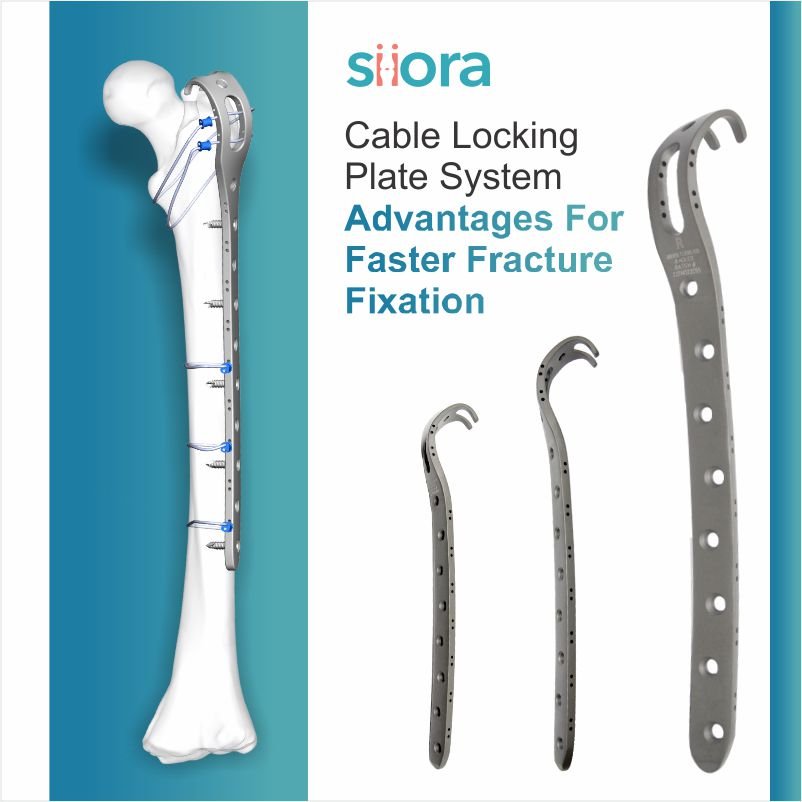Orthopedic surgeries have witnessed remarkable advancements over the years, and one of the transformative innovations in fracture fixation is the cable locking plates system. This advanced surgical method has redefined how fractures are treated, offering numerous benefits over traditional fixation systems. Cable Locking plates and screws are used for the treatment of different types of fractures including periprosthetic fractures in the long bones, osteopenic bone fractures, and periprosthetic long bone fractures. In this blog, we delve into the advantages of cable plate systems, particularly their role in achieving faster fracture fixation, improved stability, and better patient outcomes.
What Are the Advantages of Cable Locking Plate System?
Enhanced Stability and Fixation
The primary advantage of cable locking plate systems is their ability to provide superior stability during fracture fixation. Traditional fixation methods often rely on screws or plates, which can lead to micromotion at the fracture site, hindering healing. Locking cable plate systems, however, combine the use of cables and locking screws to distribute stress evenly across the bone.
This innovative design minimizes the risk of hardware failure and enhances load sharing. The locking mechanism ensures that screws remain secure, reducing the likelihood of loosening over time. This increased stability accelerates the healing process by maintaining optimal conditions for bone regeneration.
Reduced Surgery Time
Faster surgeries are critical in minimizing patient exposure to anesthesia and reducing the risk of complications. Locking Cable plate systems are designed to simplify the surgical process. Their pre-contoured plates and easy-to-use cable mechanisms allow surgeons to achieve fixation with greater precision and less effort. This streamlined approach significantly reduces operative time, making it a preferred choice for surgeons tackling complex fractures.
Moreover, shorter surgical times lead to reduced strain on healthcare systems and personnel, increasing efficiency in operating rooms.
Adaptability to Complex Fractures
Not all fractures are straightforward. Comminuted fractures, fractures in osteoporotic bones, and periarticular fractures pose unique challenges. Cable locking plate systems are highly adaptable, making them suitable for such complex cases. The flexibility of cables allows surgeons to secure fragments that might otherwise be difficult to stabilize using conventional plates or screws alone.
This adaptability ensures that even the most intricate fracture patterns can be addressed effectively, reducing the risk of nonunion or malunion. Patients benefit from improved functional outcomes and reduced post-surgical complications.
Minimally Invasive Techniques
Cable locking plate systems are often used in conjunction with minimally invasive surgical techniques (MIST). These techniques involve smaller incisions, which reduce soft tissue disruption and preserve the surrounding blood supply to the bone. Maintaining this blood supply is crucial for effective bone healing.
Minimally invasive approaches also result in shorter hospital stays, faster recovery times, and less postoperative pain for patients. For surgeons, the reduced complexity of the procedure allows for better precision and fewer intraoperative challenges.
Improved Load Distribution
Fractures are subject to mechanical forces that can impede healing if not adequately managed. Cable locking plate systems excel in distributing these forces uniformly across the fixation site. The combination of cables and locking screws works synergistically to prevent stress concentration, which is a common issue with traditional fixation methods.
This even distribution of mechanical forces reduces the likelihood of implant failure, promoting a stable environment for bone healing. Patients experience fewer complications, and the risk of requiring revision surgery is significantly diminished.
Suitability for Osteoporotic Bones
Osteoporotic bones are notoriously challenging to fixate due to their brittle nature and reduced bone density. Traditional screws often fail to achieve adequate purchase in such bones, leading to instability and prolonged healing times. Cable locking plate systems overcome this challenge by providing an alternative anchoring mechanism.
The cables wrap around the bone, offering supplemental locking plate fixation that does not rely solely on screw purchase. This feature makes the system an excellent choice for elderly patients or those with conditions that compromise bone quality.
Reduced Hardware Prominence
Hardware prominence can lead to patient discomfort, soft tissue irritation, and the need for implant removal surgeries. Cable locking plate systems are designed to minimize this issue. The plates are low-profile and contour anatomically to the bone, reducing the risk of prominence.
For patients, this means a more comfortable postoperative experience and fewer complications related to hardware irritation. The reduced need for secondary surgeries improves overall patient satisfaction and outcomes.
Faster Functional Recovery
The ultimate goal of any fracture fixation method is to restore function as quickly as possible. Cable locking plates of fractures contribute to faster functional recovery by ensuring stable fixation and promoting early mobilization. Patients can begin weight-bearing and physical therapy sooner, which is critical for preventing complications such as muscle atrophy and joint stiffness.
Early mobilization not only accelerates physical recovery but also improves psychological well-being by reducing the time patients spend immobile or dependent on caregivers.
Biomechanical Advantages
Biomechanics play a crucial role in the success of fracture fixation. Cable locking plate systems are engineered with a deep understanding of these principles. The locking screws provide angular stability, while the cables offer circumferential support. Together, they create a construct that mimics the natural biomechanics of the bone.
This biomimetic approach enhances the system’s ability to withstand physiological loads, making it a reliable solution for a wide range of fractures.
Versatility in Application
The versatility of cable locking systems cannot be overstated. They are suitable for use in various anatomical locations, including the clavicle, pelvis, and long bones such as the femur and tibia. Their adaptability makes them an invaluable tool in the orthopedic surgeon’s arsenal.
Additionally, advancements in material science have led to the development of systems that are lightweight, durable, and resistant to corrosion, further enhancing their utility across diverse clinical scenarios.
Cost-Effectiveness
While the initial cost of locking cable plate systems may be higher than traditional fixation methods, their long-term benefits make them a cost-effective choice. Faster surgeries, reduced complication rates, and fewer revision procedures translate into overall savings for healthcare systems.
Patients also benefit financially by avoiding extended hospital stays and additional surgeries, making this system a win-win for all stakeholders.
Conclusion
The cable locking plate system represents a significant leap forward in the field of fracture fixation. Its ability to provide enhanced stability, reduce surgical time, and adapt to complex fractures makes it an invaluable tool for orthopedic surgeons. For patients, the system offers the promise of faster recovery, reduced discomfort, and improved outcomes.
As research and development continue to refine these systems, their role in modern orthopedics will only grow. By combining innovative design with biomechanical principles, locking cable plate systems are setting new standards in the treatment of fractures, ensuring that patients regain their mobility and quality of life more quickly and effectively than ever before.
Siora Surgicals Pvt. Ltd. is a leader in manufacturing and supplying an international standard range of locking cable plate systems and other orthopedic devices in India. With over 3 decades of experience in the industry, the company has established a huge distributor base in 50+ countries. Additionally, Siora is also planning to mark its name among the best orthopedic device manufacturers in USA.








